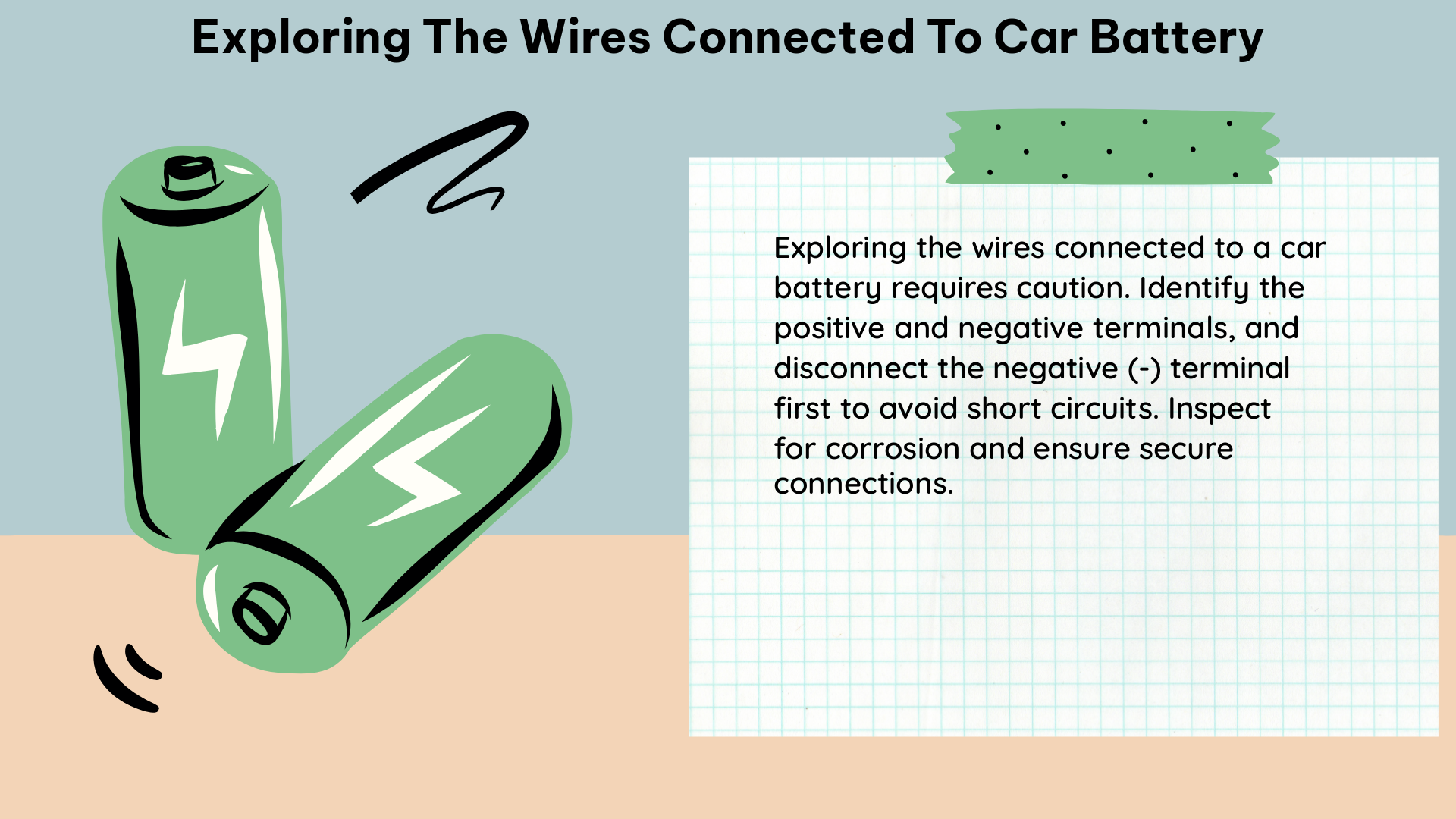The wires connected to a car battery are the lifeblood of the vehicle’s electrical system, powering everything from the starter motor to the headlights. Understanding the intricacies of these connections is crucial for maintaining the health and performance of your car. In this comprehensive guide, we’ll dive deep into the technical details and hands-on exploration of the wires connected to a car battery.
Understanding the Basics
The car battery is typically connected to the vehicle’s starter motor, alternator, and other electrical components through a series of wires. The positive terminal of the battery is usually connected to the starter motor and other high-current devices, while the negative terminal is connected to the vehicle’s chassis, which acts as a ground.
The gauge of the wires connected to the battery is essential for the proper flow of electrical current. Thicker wires, typically 4 or 2 AWG (American Wire Gauge), are used for high-current applications, such as the connection between the battery and the starter motor. Thinner wires, such as 10 or 12 AWG, are used for lower-current applications, like the connections to sensors and other low-power devices.
The length of the wires is also an important consideration. Longer wires can result in voltage drop, which can reduce the effectiveness of the electrical system. To minimize voltage drop, it’s essential to use appropriately sized wires for the length of the run. As a general rule, the longer the wire, the thicker it should be to maintain the desired voltage level.
Connecting Jumper Cables

When connecting jumper cables to a car battery, it’s crucial to follow the proper procedure to avoid sparks and potential damage to the electrical system. The positive cable should be connected to the positive terminal of the battery, and the negative cable should be connected to the negative terminal or a grounded metal surface on the vehicle. Connecting the cables in the wrong order or to the wrong terminals can result in sparks, which can be dangerous in the presence of hydrogen gas, which is produced during the charging of lead-acid batteries.
Advanced Hands-On Exploration
When exploring the wires connected to a car battery, it’s essential to have the right tools and safety equipment. Here are some advanced hands-on details to keep in mind:
- Use a Digital Multimeter: Measure the voltage and resistance of the wires and connections to identify any issues with the wiring or connections.
- Check the Battery Terminals: Inspect the battery terminals for corrosion or damage, as this can cause a poor connection and reduce the performance of the electrical system.
- Inspect the Wires: Carefully examine the wires for any signs of damage, such as cuts, abrasions, or fraying, which can lead to a poor connection or even a short circuit.
- Check the Fuses: Ensure that the fuses in the vehicle’s fuse box are in good condition and properly rated for the current-carrying capacity of the wires.
- Use a Wire Stripper: Properly prepare the wires for connection by stripping the correct amount of insulation to ensure a secure and reliable connection.
- Use a Crimping Tool: Crimp the wires to the terminals or connectors to create a strong, low-resistance connection.
- Use Heat Shrink Tubing: Insulate and protect the connections with heat shrink tubing to prevent corrosion and damage.
Technical Specifications
When exploring the wires connected to a car battery, it’s important to understand the technical specifications that govern their performance and safety. Here are some key factors to consider:
- Wire Gauge: The gauge of the wire refers to its cross-sectional area and affects its current-carrying capacity. For example, a 4 AWG wire has a higher current-carrying capacity than a 10 AWG wire.
- Wire Length: The length of the wire affects its resistance and voltage drop. Longer wires have higher resistance and greater voltage drop, which can impact the performance of the electrical system.
- Voltage Drop: Voltage drop is the decrease in voltage as the current flows through the wire. A high voltage drop can cause issues with the electrical system, such as reduced performance or even component failure.
- Resistance: Resistance is the opposition to the flow of current. A high resistance can cause issues with the electrical system, such as reduced power output or increased heat generation.
- Fuses: Fuses protect the electrical system from overcurrent. The fuse rating should match the current-carrying capacity of the wire to ensure proper protection.
- Connectors: Connectors are used to connect the wires to the battery and other electrical components. The connectors should be rated for the current-carrying capacity of the wire to ensure a secure and reliable connection.
By understanding these technical specifications and applying the advanced hands-on techniques, you can effectively explore and maintain the wires connected to your car battery, ensuring the optimal performance and longevity of your vehicle’s electrical system.
References:
- How to connect a jumper cable to this battery? – Mechanics Stack Exchange. https://mechanics.stackexchange.com/questions/73779/how-to-connect-a-jumper-cable-to-this-battery
- ELI5: Why is it important to connect the red cable before the black cable when jump starting a car? – Reddit. https://www.reddit.com/r/explainlikeimfive/comments/13eyfb3/eli5_why_is_it_important_to_connect_the_red_cable/
- Need help understanding how to hook up a Mobile radio to the car battery – RadioReference Forums. https://forums.radioreference.com/threads/need-help-understanding-how-to-hook-up-a-mobile-radio-to-the-car-battery.465146/

The lambdageeks.com Core SME Team is a group of experienced subject matter experts from diverse scientific and technical fields including Physics, Chemistry, Technology,Electronics & Electrical Engineering, Automotive, Mechanical Engineering. Our team collaborates to create high-quality, well-researched articles on a wide range of science and technology topics for the lambdageeks.com website.
All Our Senior SME are having more than 7 Years of experience in the respective fields . They are either Working Industry Professionals or assocaited With different Universities. Refer Our Authors Page to get to know About our Core SMEs.